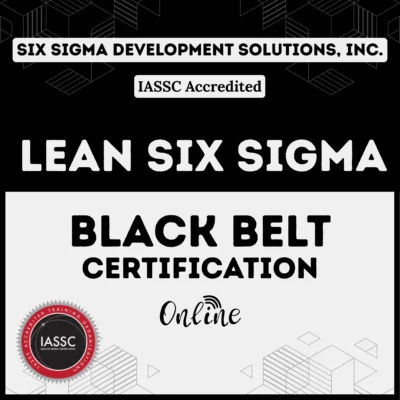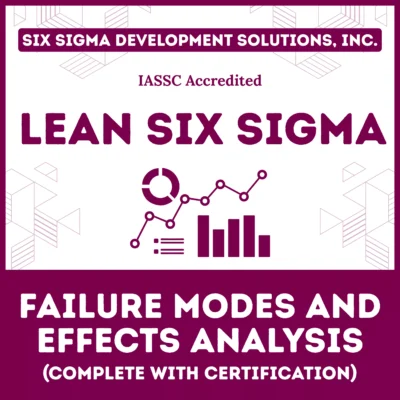The challenge of determining which tasks to prioritize—given resource constraints—can be daunting. This is where Weighted Shortest Job First (WSJF) prioritization comes into play.
By focusing on the most economically impactful tasks that can be completed quickly, WSJF helps streamline workflows and maximize return on investment (ROI). It is particularly useful in agile and lean environments where teams continuously adapt to changing circumstances.
Table of contents
What is Weighted Shortest Job First (WSJF)?
WSJF is a prioritization framework. It is designed to help teams determine the order in which tasks or initiatives should be tackled to maximize economic benefit. Rooted in Lean principles and Critical Chain Theory, WSJF provides a structured, data-driven approach to identifying which tasks will yield the highest return, in the shortest amount of time.
The goal of WSJF is simple: deliver the most value in the shortest time. By calculating the cost of delay against the job’s duration, it ranks tasks based on their potential to provide the greatest economic impact. Rather than relying on subjective decisions or guesswork, WSJF uses objective data to guide teams toward making informed prioritization choices.
WSJF, used primarily within the Scaled Agile Framework (SAFe), is a prioritization approach. It ensures that teams sequence work to maximize economic value. This approach prioritizes jobs or tasks that deliver the highest value in the shortest time over others, given they offer the highest relative return.
Why Use WSJF?
WSJF is especially valuable in agile and lean environments where the goal is to deliver high value quickly. The methodology aligns well with Lean principles, which aim to maximize value while minimizing waste.
By continuously evaluating and adjusting priorities based on WSJF, teams ensure they focus on tasks that offer the most value with the least effort, avoiding the waste of time and resources on low-priority tasks.
The primary goal of using WSJF is to optimize the flow of work and maximize the economic return on investment (ROI) over time. It helps teams continuously make adjustments to their priorities based on shifting needs, changing market conditions, and new insights.
Here’s why WSJF works:
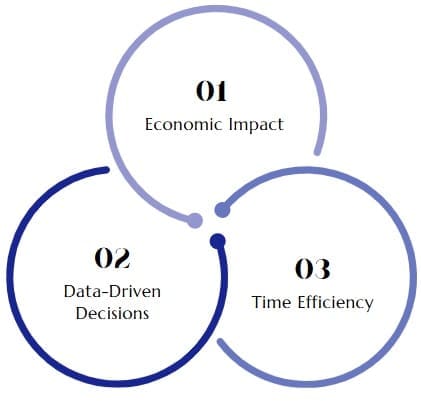
- Economic Impact: WSJF incorporates financial aspects, such as revenue loss, competitive advantage, and risk exposure. This makes it easier for teams to focus on work that directly drives business outcomes.
- Data-Driven Decisions: Unlike subjective prioritization methods, WSJF is a data-driven approach that quantifies each task’s importance, providing a rational and transparent method for backlog management.
- Time Efficiency: By prioritizing tasks with high economic value that can be completed quickly, WSJF ensures teams maximize their limited time and resources.
Key Components of WSJF
To understand how WSJF works, we need to break it down into its key components:
1. Cost of Delay (CoD)
The Cost of Delay is a crucial factor in the WSJF formula. It quantifies the financial or strategic loss resulting from a task or initiative’s delay. The cost of delay breaks down into three main components:
- Business and User Value: This refers to the importance of the task to the business or end-users. Higher business value tasks—those that drive revenue, improve customer satisfaction, or fulfill critical business needs—are considered more valuable.
- Time Criticality: This measures how urgent the task is. A task is deemed highly time-critical if delaying it would result in significant business loss, such as losing competitive advantage or market share.
- Risk Reduction and/or Opportunity Enablement: Some tasks may not directly deliver immediate business value, but they reduce future risk or enable future opportunities. For instance, technical debt reduction or the development of infrastructure to support future features could be highly valuable in this context.
To calculate the Cost of Delay, teams typically rate each of these factors on a scale, such as 1 to 10. Then, they add the scores together to determine a Cost of Delay score.
2. Job Duration or Size
The Job Duration or Size refers to the estimated time or effort required to complete the task. It takes into account factors like the complexity of the job, dependencies on other tasks, resource availability, and the level of expertise required. Completing a job in a shorter time frame makes it more valuable to do first. This enables teams to move on to the next task more quickly.
Unlike traditional project management, which often calculates time in person-hours or weeks, WSJF uses relative estimates. Teams assign tasks a score based on their duration, with lower numbers indicating shorter tasks that can be completed quickly.
3. The WSJF Formula
After calculating the Cost of Delay and Job Duration, teams can determine WSJF using a simple formula:

Teams should prioritize the task or initiative with the highest WSJF score. This is because it offers the most value in the shortest amount of time.
How formula work?
The WSJF formula prioritizes items with the highest Cost of Delay and the smallest Job Size. A higher WSJF score means that delaying the item has a greater economic impact, and/or the item can be delivered faster. This makes it a higher priority.
In essence, WSJF helps answer the question: “What is the most valuable thing we can do now that will have the least delay cost and take the shortest time to deliver?”
By calculating the WSJF score for each item in the backlog, teams can create a prioritized list, ensuring that they focus on delivering the most value in the shortest amount of time. This leads to better resource allocation, faster time-to-market for valuable features, and ultimately, a greater return on investment.
How is WSJF Applied?
WSJF is typically used to prioritize tasks in various backlogs. This could apply to product development backlogs, marketing campaign backlogs, or any other initiative that requires sequencing.
Steps to Calculate WSJF
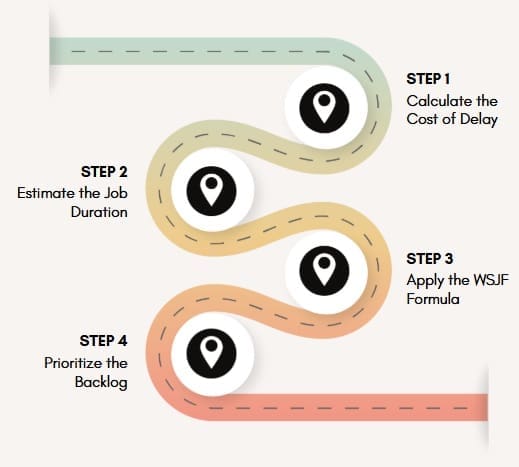
Here’s a simple process teams can follow to apply WSJF:
Step 1: Calculate the Cost of Delay
- Value to the Business/User: Assess the importance of the task based on user feedback, business needs, and market conditions.
- Time Criticality: Evaluate whether the task is time-sensitive, either due to external factors or competitive pressures.
- Risk Reduction/Opportunity Enablement: Consider whether the task mitigates risk or opens up new opportunities.
Each of these factors is given a score, and the sum of those scores gives the Cost of Delay.
Step 2: Estimate the Job Duration
Determine how long it will take to complete each task. This can be tricky, as various factors (e.g., dependencies, team experience) can affect duration. Nonetheless, the team needs to come to a consensus on a relative scale for job size or duration.
Step 3: Apply the WSJF Formula
Use the formula: WSJF = Cost of Delay / Job Duration to calculate a WSJF score for each task. Rank the tasks based on their WSJF scores.
Step 4: Prioritize the Backlog
Arrange the tasks from highest to lowest WSJF score. This will give the team a prioritized list of initiatives to work on, ensuring that they focus on those that offer the most significant economic benefit.
Best Practices for Implementing WSJF
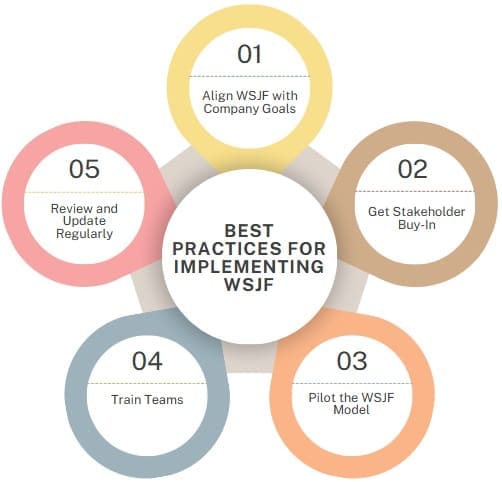
To ensure the effective use of WSJF, follow these best practices:
- Align WSJF with Company Goals: Ensure that the factors used to calculate WSJF (cost of delay, job duration, etc.) align with your organization’s overall strategy and objectives.
- Get Stakeholder Buy-In: Share the benefits of WSJF with stakeholders and gain their support for this data-driven approach to prioritization.
- Pilot the WSJF Model: Test WSJF on one team or project before scaling it to other areas of the organization. This allows you to refine the process and address any challenges.
- Train Teams: Provide training on the WSJF methodology to ensure that teams consistently apply the framework and understand how to estimate job duration, cost of delay, and prioritization factors.
- Review and Update Regularly: As market conditions and business needs evolve, make sure to regularly review and update the WSJF calculations to reflect current realities.
Benefits of Using WSJF
- Maximizes Economic Value: By focusing on high-value tasks that can be completed quickly, WSJF ensures efficient resource use and maximizes the organization’s return on investment.
- Aligns Teams Around Common Goals: Since WSJF uses a clear and measurable formula, it helps teams align their priorities around business value, making decision-making more objective and data-driven.
- Enables Continuous Prioritization: Unlike traditional methods that often require static decisions, WSJF is dynamic. Teams can recalibrate the prioritization as conditions change, such as new market opportunities or shifting customer needs.
- Promotes Collaboration: When teams collectively calculate the Cost of Delay and Job Duration, they build shared understanding and alignment, leading to better communication and decision-making.
Challenges and Considerations
Despite its many benefits, using WSJF can be challenging. For example:
- Estimating Job Duration: Accurately estimating how long a task will take can be difficult, especially in complex environments with many variables. Teams must develop consistent methods for job size estimation to make this process effective.
- Subjectivity in Cost of Delay: Determining the value, time criticality, and risk reduction for each task often involves subjective judgment. Without clear criteria or data, this could lead to inconsistencies in how different teams apply WSJF.
- Dependency Management: Some tasks depend on the completion of others, which may skew the prioritization if not carefully managed.
Final Words
Weighted Shortest Job First (WSJF) is a powerful and effective prioritization model for teams looking to maximize economic value while optimizing their workflow. By considering both the value of the task and the time required to complete it, WSJF ensures that teams work on the most impactful tasks first.
While the approach has some challenges, such as estimating job duration and aligning subjective factors in the Cost of Delay, its ability to help teams prioritize efficiently makes it an invaluable tool in agile frameworks like SAFe.
In an increasingly competitive and fast-paced business landscape, WSJF provides the agility needed to respond quickly to market shifts, customer needs, and other changing conditions, ensuring that organizations continue to deliver value efficiently and effectively.





